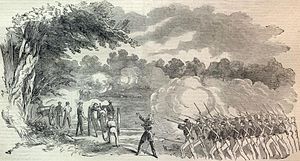- In Missouri, US Brigadier General Nathaniel Lyon, after occupying the state capitol at Jefferson City without firing a shot, has pursued the Missouri State Guard and Governor Claiborne Jackson to Boonville, in Cooper County, Missouri. Against the advice of his senior officers including Gen. Marmaduke, Missouri Governor Claiborne Jackson exercises his authority as state commander-in-chief and orders the Missouri State Guard to make a stand at Boonville. In the Battle of Boonville, Missouri, Lyon's 1,400 volunteers and regular US Army troops rout the Missouri State Guard. Casualties are extremely light, but very strategic for the future of Missouri. Jackson, the State Guard, and pro-secessionist members of the General Assembly retreat to southwest Missouri, near the Arkansas border, leaving Lyon’s Federal army in control of the Missouri River, and thereby most of the north and east of the state, effectively thwarting efforts to bring Missouri officially into the Confederacy./1861
- The Second Wheeling (Virginia) Convention unanimously declares western Virginia independent of the Confederate portion of the State./1861
- Spain proclaims neutrality in the War between the States, but recognizes the Confederacy as a belligerent power, a good diplomatic sign for the Confederacy./1861
- Skirmishing and probes continue along the Potomac River front at Conrad's Ferry, New Creek, and Vienna, Virginia. A train of cars with 275 Ohio volunteers is fired into near Vienna, Virginia, and 8 men are killed and 12 wounded. No one takes responsibility./1861
- At Washington, President Lincoln observes Professor Thaddeus S.C. Lowe demonstrate the use of a hot-air balloon for reconnaissance operations and even communicate by telegraph from the air. Some military advisors want to employ balloons to observe enemy movements. The self-taught and self-named Professor Lowe, who looks remarkably like the man behind the curtain in the Wizard of Oz, had been working on a transatlantic crossing in a balloon, but two test flights had failed. The first failed when the balloon sustained a tear. The second when he took off April 19, 1861, from Cincinnati headed to New York. Unfortunately he instead landed in Union, South Carolina, and was arrested as a Yankee spy. The South Carolina authorities released him when he proved his scientific interests only to them, but US Secretary of the Treasury Salmon P. Chase recognized the strategic value of the balloons and invited him to Washington for this demonstration for the President. In July 1861 Lowe would be appointed Chief Aeronaut of the Union Army Balloon Corps by President Abraham Lincoln./1861
- According to the Richmond Daily Dispatch (June 20, 1861), in the early morning four New Orleans Zouaves leave camp at Bethel, Virginia, without leave for Newport News, allegedly to reconnoiter the area’s fortifications. Five or six hours later, only one of them returns to camp -- exhausted and carrying a large, bloody bowie knife. According to the lone Zouave, about 1 ½ miles from Newport News, they were surrounded by a 20-30 member Yankee scouting party. Armed with nothing but bowie knives, they determined to cut their way out and went to work with a will. Despite killing several of the Yankees, he alone escaped; the other three taken prisoners./1861
 Image via Wikipedia Image via Wikipedia |
| Battle of Boonville, Missouri |
 |
| Prof. T.S.C. Lowe |
 Image via Wikipedia Image via Wikipedia |
| Prof. Lowe in his balloon |
 Image via Wikipedia Image via Wikipedia |
| Bowie knife |

great blog.. if you looking for western bowie knife feel free to click the link
ReplyDelete